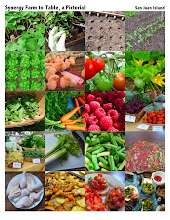Raw Sauerkraut
We have a ton of cabbage and this is an easy way to get raw super tasty sauerkraut. Fermented cabbage is helpful for detoxifying harmful chemicals and hormones from the body.
- 1 medium cabbage, cored and shredded
- 1 Tbs caraway seeds
- 1 Tbs sea salt
- 1 Tbs juniper berries (optional)
Directions
- In a bowl, mix cabbage with caraway seeds, and salt. Pound with wooden pounder, potato masher, or a meat hammer for about 20 minutes to release juices. Place in a quart-sized, wide-mouth mason jar and press down firmly with a pounder or meat hammer until juices come to the top of the cabbage. The tip of the cabbage should be at least 1/4 inch below the top of the jar.
- Pack the cabbage tightly into the jar. Place the bottom of a Ziploc bag into the jar and press it firmly a along the surface of the jar and the cabbage. Fill the bag with water until water reaches the lip of the jar. The water provides weight to keep the cabbage submerged. Screw a lid on the jar over the plastic bag. Label the jar with the date.
- Cover tightly and keep at room temperature for about 3 days before transferring to cold storage. The sauerkraut may be eaten immediately, but it improves with age.
Yield: 1 quart
From "Nourishing Traditions" by Sally Fallon
Braised Cabbage and Carrots with Mint and Cider Vinegar
Braising is a great technique for infusing greens and vegetables with flavor. Braising cabbage brings out its natural sweetness. Apple cider vinegar adds brightness to the dish and aids in digestion.
- 2 lbs green or napa cabbage, about 1 medium head
- 3 Tbs butter
- 1 large yellow onion, sliced
- 2 medium carrots, cut into ¼ inch rounds
- Sea salt and freshly ground black pepper
- Homemade or low sodium vegetable stock or chicken stock
- 2 Tbs apple cider vinegar
- 1/2 cup mint, chopped
Directions
- Cut the cabbage into quarters and cut out the core. Chop into 1 inch pieces.
- Heat a large wide pan on medium-high heat. Add the butter, onion, carrot, and cabbage and season with salt and pepper. Saute for a few minutes.
- Add the vinegar and enough stock to cover the vegetables about 3/4 of the way up. Bring to a boil and then turn the heat down to a simmer and uncover. Allow to cook until almost all the liquid is cooked out and the vegetables brown a little.
- Season again if necessary.
- Remove to a platter and garnish with the chopped mint.
Servings: 6-8
Sausage and Kale Soup
This soup is surprisingly easy and delicious and it’s a satisfying way to eat more kale. Give it a try.
- 1 tablespoon olive oil
- 1 onion, diced
- 2 garlic cloves, minced
- 1/4 teaspoon crushed red-pepper flakes
- 5 waxy potatoes (1 1/2 pounds), peeled and cut into 1/2-inch chunks
- 2 quarts homemade or reduced-sodium chicken broth
- 1 bunch kale (12 ounces), stemmed and shredded
- 12 ounces spicy sausage, cut into 1/2-inch half moons
Directions
- In a large pot (6 to 8 quarts), heat oil over medium. Add onion and cook until soft, stirring, 2 to 3 minutes. Add garlic and red-pepper flakes; cook until fragrant, 1 minute. Add potatoes and broth; bring to a boil. Reduce heat; simmer until potatoes are tender, 10 to 15 minutes.
- Cut sausage and cook over medium heat in a skillet. When cooked all the way through set aside.
- In a blender, puree half the soup. Return to pot; add kale and sausage. Simmer until kale is wilted, 10 to 15 minutes.
Serves 6



























